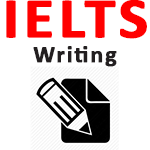
Book an On-line EDUZMS IELTS Writing course
Book an On-line EDUZMS IELTS Writing mock test
This is the IELTS with James information about the IELTS Academic Writing exam.
The Writing exam consists of two tasks; Task 1 and Task 2 and candidates are given 1 hour to complete it. Each exam is done on a group basis, that is, you will be with other candidates in a room all doing the exam together.
Minimum of 150 words
In Task 1, you are presented with a graph, table, chart or diagram and are asked to describe, summarise or explain the information in your own words. You may be asked to describe and explain data, describe the stages of a process, how something works or describe an object or event.
Minimum of 250 words
In Task 2, you are asked to write an essay in response to a point of view, argument or problem.
The issues raised are of general interest to, suitable for and easily understood by test takers entering undergraduate or postgraduate studies or seeking professional registration.

Assessment
You are assessed in four categories; Task Achievement/Response, Coherence and Cohesion, Lexical Resource (Vocabulary), and Grammatical Range and Accuracy. Each of these categories is marked between 0 and 9, with 0 being the lowest and 9 being the highest.
In Task 1 it is called Task Achievement, whereas in Task 2 it’s called Task Response. Fundamentally, they both as measuring how well you answered the question and whether your writing is correct and directly answering the question.
This measures the range of vocabulary you have and whether you can use less common words and idioms. If you use the same kinds of words for all your answers you won’t get a high score in this element.
This element measures whether your response/answer is both logical, understandable and easy to follow. The easiest example of coherence is something in chronological order(time order). If you write about 2010, then 2016, then 2000 and lastly 2014, this is not in a logical/coherent order. It also measures the flow of the text not only between paragraphs, but also between sentences and how many different cohesive words you use.
In this part you are measured on the range of grammar you use. So, what this means is; do you use different types of sentence? Are they simple or complex? Are the tenses correct? etc. The more complex sentences you can use (and that are correct) the higher you score will be. That not to say you shouldn’t use some simple sentences too!
For more details on what examiners are looking for, please download the official IELTS Writing Band Descriptors or email us at IELTS with James, and we’ll send one over to you.